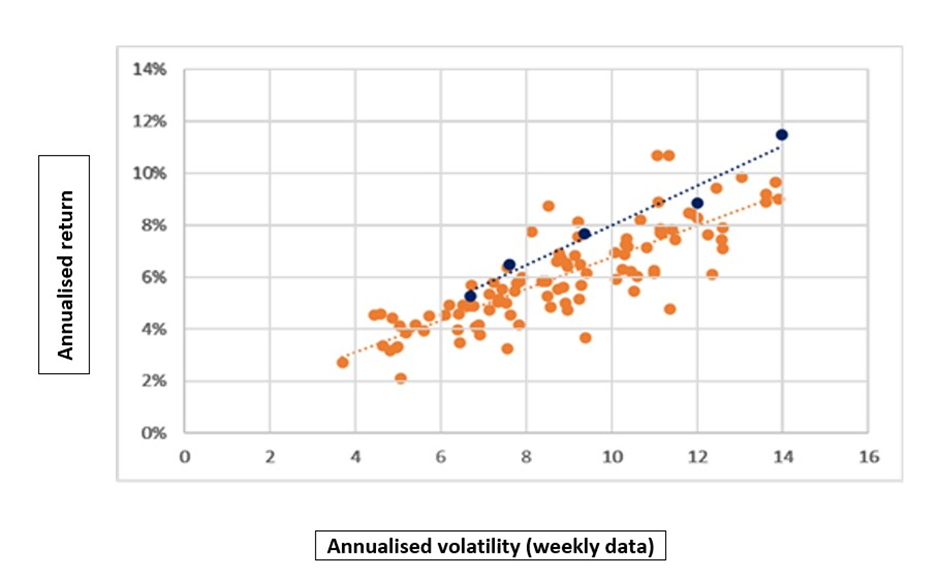Comparing funds in the IA Volatility Managed sector is difficult due to their myriad volatility targets. So, what happened when we built a benchmark of our own?
Investors were warned from the start.
When the Investment Association (IA) launched the Volatility Managed sector a little under five years ago, it cautioned against using it to compare funds. This is because those it contains use different volatility targets, making at-a-glance comparisons almost meaningless.
So, how can advisers assess funds within the sector? Is it possible to build a benchmark?
The irrelevance of average
One of the characteristics of the IA Volatility Managed sector is its diversity.
Fund suites use different definitions of volatility (realised or projected, for example) and various timeframes. The sector also encompasses funds with different risk levels (including within a single fund family), so its performance average effectively pools them together. The average also skews towards the risk levels with the most representation.
Different definitions of volatility exacerbate a problem that already exists in the world of multi-asset: how to benchmark and cluster funds. While single asset class funds enjoy broad benchmarks and allow managers to take active risk through security selection and portfolio weighting and trading, the benchmarking of multi-asset funds tends to be fund specific.
As a result, grouping tends to be done on a best-effort basis, through exposures (as with the Mixed Investments 20%-60% Shares sector) or risk rating, which is more complex.
The issue is compounded by the fact that, even where we have comparable definitions, diverse levels of volatility are still being pooled. The IA Volatility Managed sector not only mixes apples with pears, but small apples with big apples.
How to benchmark funds
To build a benchmark, we need to pool funds of similar methodologies, and of similar levels of volatility within those methodologies.
An immediate barrier is that data on methodologies and volatilities may not be readily accessible. Instead, we can look at funds' track records if their lifespan is long enough.
One option is to look at funds' underlying exposures through time. To build a peer group, we can track whether a group of funds maintains similar exposures or hold combinations of exposures conducive to similar levels of expected volatility.
Another route is to group funds according to a metric based on realised returns, such as the standard deviation of returns, through time (if the similarity persists). One caveat here is that one asset mix may have a different short-term volatility to another, but the forecasted volatility of a longer-term investment may be similar.
We can go further still. By using a common metric (such as one or more of those proposed above) across all funds, and discovering how each rewarded its investors for the risk they had taken, this presents advisers and investors with a methodology to compare funds within the sector.
Interestingly, this also allows us to see how incremental risk is compensated within fund families, and how this compares with other fund suites.
What does this analysis show?
Using the approach described above, here is the outcome plotted on a graph.
It blends the returns and volatilities of all funds within IA Volatility Managed over the last five years (to 30 November 2021). The five Horizon Multi-Asset funds are shown in black.

In any analysis that includes historical data, it is important to remember that each portfolio manager considered the circumstances and opportunities of the time (and markets reacted to those conditions), so comparisons and analysis based on past circumstances may not be representative of current ones.
However, with the IA considering how it can apply performance metrics to the Volatility Managed sector, custom benchmarks are advisers' best chance of understanding outcomes for clients invested within it.
In summary
- The IA Volatility Managed sector contains both single funds and fund families that target various levels of volatility, as well as funds using different volatility methods, giving a broad range of risk and return outcomes
- In the IA's own words, advisers and investors should therefore not use the sector average for comparing fund performance as this would not give a like-for-like comparison
- Building custom benchmarks is complex, but possible, by looking at funds with similar methodologies and levels of volatility over time.
- Using the Sharpe ratio, this provides one possible way of comparing funds within the Volatility Managed sector.
Horizon funds, reclassified
On 5 November 2021, Embark Investment reclassified its Horizon fund range from the Investment Association (IA) Mixed Investment sector to the IA Volatility Managed sector, and changed the funds' asset allocation guidelines and Prospectus.
The funds' new home better reflects their outcomes-based approach, while the change to the guidelines allows for greater investment flexibility. Find out more about the changes at embarkhorizon.co.uk/changes-to-funds-prospectus/
The information, materials or opinions contained on this website are for general information purposes only and are not intended to constitute legal or other professional advice and should not be relied on or treated as a substitute for specific advice of any kind.
We make no warranties, representations or undertakings about any of the content of this website; including without limitation any representations as to the quality, accuracy, completeness or fitness of any particular purpose of such content, or in relation to any content of articles provided by third parties and displayed on this website or any website referred to or accessed by hyperlinks through this website.
Although we make reasonable efforts to update the information on this site, we make no representations, warranties or guarantees whether express or implied that the content on our site is accurate complete or up to date.


